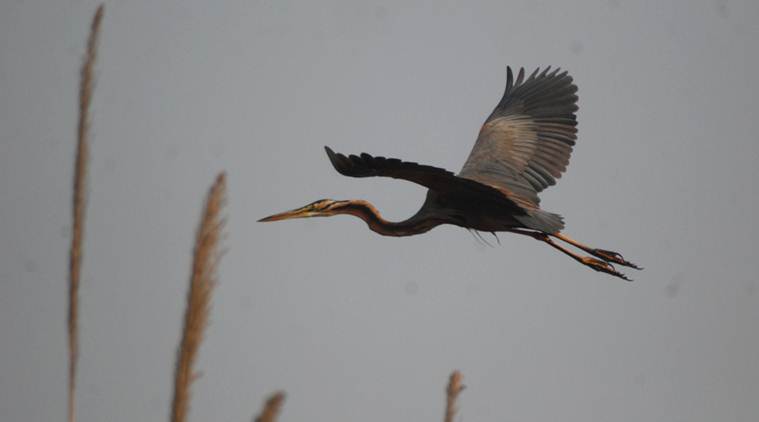- India
- International
Down in jungleland: Stealth in the Swamps
Supreme control and a zen-like demeanour – the leggy heron offers us much to learn from.
 The deadly monk of the skies: Herons are slow, sure and as effective a hunter as any bird out there.
The deadly monk of the skies: Herons are slow, sure and as effective a hunter as any bird out there.
If you have an attention-deficiency problem, cannot focus and are driving everyone nuts by your constant fidgeting and indecisiveness, watch herons. Just looking at these long-legged waterbirds in their swampy habitats can be therapeutic — there’s a stillness and calmness about herons that few other birds possess and most fishermen would envy. This is accompanied by deadly intent: the basilisk-like eyes remain riveted on the water, and the bird may be completely still; or, it can be the epitome of stealth as, with utmost care, it places one long scaly leg ahead of the other while wading through the muddy gook. Then, the laid-back Z neck flashes forward and the javelin-like bill spears into the water, usually emerging with a wriggling silver fish or a hapless, impaled frog – which is gulped down. Then, the stillness returns.
How easy or not it is to spot the birds and indulge in a bit of this “heron yoga” will depend on the species you encounter. This family of around 64 species of fishermen (of which around 23 are found in India) includes members whose camouflage plumage turns them virtually invisible — the bitterns — as well as angelic white egrets who are very happy following herds of cattle and foraging on garbage heaps well away from water. There are also the more conventional larger herons, which stand 5 feet tall, that prowl the banks of waterbodies pretty much the world over.
Generically speaking, herons are long-legged wading birds that range in size from a foot to 5 feet tall; they have long elastic necks with a kink in the middle which gives them the unique Z neck profile in flight. They are unhurried and deliberate in their movements — until the moment the spear bill flashes down. Usually dressed in brown, grey, blue, white, purple or resin, they may be speckled, streaked or barred and their plumage is soft and silky. They have “powder down” patches on the sides of their rumps and breasts, comprising feathers that have crumbled to powder, which they use as a sort of dry shampoo to sop up the fishy muck from their plumage. Partners usually dress alike and some (like the egrets) adorn themselves with filamentous plumes on the top of their heads and satin lace during the breeding season. Unfortunately, egrets in many areas were nearly hunted to extinction for these “aigrettes” which became a fashion rage in ladies’ hats. Usually, herons nest colonially (bitterns are solitary nesters) bringing up two to four or five young. They relish fishes, frogs, aquatic insects, mollusks, baby birds, eggs and rodents. Sadly, the egrets have now discovered the riches of our garbage dumps.
Hunting and fishing techniques vary. Typically, herons are found standing stock still in the water either erect or in a crouch, or like a badminton player about to serve. Then, ever so slightly the head moves from side to side as the bird gets a fix on the fish that’s been spotted and compensates for refraction. The spear bill flashes forward and the kill is made. They may even deliberately stir up the mud at the bottom with their feet to panic their prey. Some species crouch low and unfurl their wings like umbrellas to do this and to cut the glare. Others have been known to use bait – bits of bread or fruit, berries or flowers – on the water surface to bring up the fish.
The hardest to winkle out are undoubtedly, the bitterns. They’re stockier than other herons, usually streaked in golden browns and shades of straw (some are dark), play statues in the reed beds and resemble reeds to an astonishing extent (that is frustrating for birders), sometimes extending their heads and bills upwards to blend in with the reeds even more. During the breeding season (the monsoons) they “boom” — emitting a call that can been likened to you blowing over an empty bottle, amplified several times. The commonest heron in our region is the ubiquitous pond heron or paddy bird that, like policemen on duty, can be found standing morosely at intervals along the banks of water-bodies, the edges of paddy-fields, and even patrolling up and down in large gardens all over the country. They’re outfitted in streaked khaki, except in the breeding season when they turn out in a classy maroon satin. Night herons, with their ruby eyes and blade blue and white uniforms, are stockier and somewhat bat-like in flight, and the little heron, in its greeny-black is less common. The egrets have reduced their dependence on watery habitats: they first learnt to follow cattle herds, snapping up the insects disturbed by animals’ hooves (while de-ticking the animals too).

The largest herons in our region are the purple heron and grey heron: the former, in cryptic shades of resin and mauve, the latter in formal grey, white and black. It is astonishing how close you can get to these birds without spotting them (though you probably would have been under surveillance for a while): usually the birds take off with an irritable croak when you get too close. But, they fly unhurriedly and deliberately, with no sense of panic or hysteria.
The rarest heron in the world, the white-bellied heron, also resides in our neck of the woods: a breeding colony of 50 birds in the Namdapha Tiger Reserve. It’s estimated that only 250 of these survive worldwide: in Bangladesh, Myanmar and Bhutan – they’re now considered critically endangered.
So yes, if you’re a hyperventilating, mass of jangling nerves not knowing how to deal with the day’s crisis or the (demonetised) times, watch herons. Let the slow majesty of their demeanor seep into you. Then, focus — and strike!
More Lifestyle
Apr 25: Latest News
- 01
- 02
- 03
- 04
- 05




































